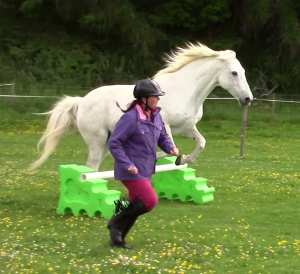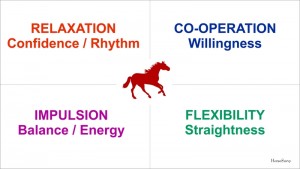 One of the hardest things I’ve found is to be able to train or teach a horse whilst still having fun.
One of the hardest things I’ve found is to be able to train or teach a horse whilst still having fun.
Horses that are innately internal and sensitive, introverted and wise (what normal folk call stubborn, lazy and stupid) are often the horses we can offend the most. They don’t show their feelings like extroverts do, they don’t run around taking offence at our high energy or kick out in a strop. They are much more subtle than that! Introverted horses need to feel they are loved just for themselves and training can’t seem like normal training to them or they become mentally, emotionally and physically braced and a brace in the mind is a brace in the body! Sometimes this brace looks like stubbornness, sometimes an extreme brace can make a horse look lame!
So, how can we find a way to help train our shy horses? I think we need to look back at our childhoods and remember why we love horses in the first place. We often have no idea why these beautiful animals tug at our hearts so much but we do know that as children we just want to run with them, play with them, brush them and love them unconditionally.
How can we train with fun you ask?
I feel we need to ‘Find the Child Within Us’ again to train with fun. Once any safety issues are smoothed out then we can still train with fun, this way we stop making it ‘personal’ to our horses and they will enjoy training and being around us.
Firstly what we we need to do is change the mental attitude we may bring to our horses when training. Our mental attitudes often are of doing things TO the horse, doing things to bring about CHANGES to the horse, doing things to the horse that changes his attitude or physicality! This is just too personal for a horse to take, it’s like ‘Bullying your Best Friend’!! If we think of our horses with us as a herd, of being partners, of being best friends and then ask for things in a way that isn’t personal then the horse won’t be offended.
Here are some idea’s:
1) When asking your horse to back up try saying something like ‘ooh, dropped something, better pick that up quickly’ and smile whilst stepping forward towards your horse. I did this the other day with my very introverted mare and she went back very willingly as there wasn’t anything about moving her backwards in my thoughts or voice, no demands, just needing to do something and she moved out of the way for me.
2) When moving hq’s maybe try saying something like… ‘ooh, forgot my gloves at the gateway’ and walk towards the horses hindquarters whilst bringing the rope slightly upwards. Horse will move their hq’s over quickly without us being specific about a particular move. We could also do same thing but move towards horses forehand for a forehand move over whilst walking.
3) Even when doing something like circling or other circular/half circular patterns we can have a totally different attitude to doing these by adding lots of ‘YES’s’ when every little thing goes right….lightness onto circle, YES, bending to the inside, YES, how beautiful horsey is, YES. Works very well when riding too, lightness off leg, YES, turning without brace, YES, leg yielding like floating dance together, YES.
4) Extreme familiarisation with stick and string can be more of a feeling of helping horses swish flies away, very good fun and they really appreciate it, with this ‘helping horse’ in our minds we have no anxiety, no agenda too.
5) With impulsion try claiming the space ‘ behind the horse in a game of ‘tag’ which gives it more of a game attitude.
6) Finding impulsion when riding can be challenging for an introverted horse too. BUT if you start with small point 2 points (going from one thing to another like corners, cones, barrels) and putting things in your mind like ‘quick, we need to get to the corner before the bear eats us’ (moving away from something) OR ‘wow, there’s a chocolate biscuit on the barrel how quickly can we get to it before someone else gets it’ (moving towards something). People are usually motivated positively by either ‘moving away’ or ‘moving towards’ things, find out which you are motivated by and use this technique for positive results.

Extroverted horses enjoy this method too as they are often very playful. If they are a worried type of horse this can work too as by making things a ‘game’ and with a playful attitude it takes fear pressure off and they can relax and learn more easily.
Our attitude and thoughts can really make a big difference between making training fun or making training work!
I hope you manage to find the child inside you and remember to have FUN 😉



